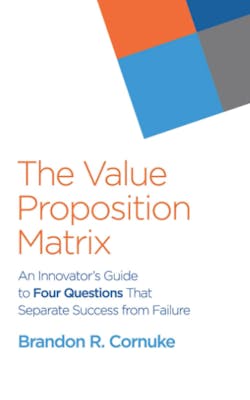What's the Difference Between a Prototype and a 'Minimum Viable Product'?
One of the most famous prototypes of all time was born in my home state of Ohio. While soft sand and privacy made the beaches of North Carolina an ideal testing ground for their invention, Orville and Wilbur Wright sketched, sawed, tied, machined, and assembled the first “powered flying machine” – the Wright Flyer – at their bicycle shop in Dayton.
Over 100 years later, innovation is still thriving in Ohio, and prototypes are still an indispensable part of the development process. In the last decade, a new concept—the Minimum Viable Product (MVP)—has emerged as way to better describe early-stage product development.
At MAGNET, a regional nonprofit consulting organization where we help Northeast Ohio manufacturers cultivate talent, transform their operations, and develop new products, we hear this term a lot. Any time a company wants to try a new idea, be it a product or service, they’ll often describe their initial version as an MVP. After all, finding a balance between the least costly (minimum) and most effective (viable) early product is a worthy ideal.However, a prototype and an MVP are not the same thing. Prototypes are meant to determine whether a concept solution works. MVPs, on the other hand, are meant to help innovators understand whether customers will pay for a concept solution. Understanding this fundamental difference can mean spending your innovation budget wisely or missing the mark completely.
First, the Origins
“Prototype” is Greek meaning “first form.” Whether it’s a flint arrow, a string of code, or a flying machine, the first version of anything can be called a prototype. It’s an initial try, a rough draft, an experiment. It’s a starting point from which to learn and improve.
The phrase Minimum Viable Product was coined in 2001 by the entrepreneur Frank Robinson and popularized by Eric Ries, author of “The Lean Startup.” To Robinson and Ries, an MVP is an early version of a product that maximizes learning while minimizing cost.
If that sounds a lot like a prototype to you, you’re not alone. I see these terms used interchangeably all the time. They are alike in a crucial way: both a prototype and an MVP are supposed to advance an idea through trial and error – in other words, they are meant to accelerate learning. To find the difference, we need to dig deeper into what, exactly, a particular innovator is trying to learn.
Wright and Wrong
The Wright Brothers were, of course, trying to learn quite a lot as they developed their aircraft – specifically whether their design worked. So, naturally, the Wright Flyer was the last in a series of failed attempts to get their flying machine to fly. It was the quintessential prototype, full of glitches, guesses, and shortcuts. It was designed for a single person to fly a short distance at a limited height and then jarringly land by skidding to a halt. It’s a far cry from the advanced aircraft we have today. Yet, it shares many of the same fundamental components – wings, engines, controls. It wasn’t designed to transport a family to their beach vacation or spot enemy tanks high above a battlefield. It was designed to do one thing: prove that a heavier-than-air machine could achieve sustained flight. And it did exactly what it was designed to do. In other words, it proved that the Wrights’ concept worked.
Now, consider the situation the Wright Brothers found themselves in when trying to sell their successful invention. They assumed, having built a working prototype, that customers all over the world would line up to buy their product. They had good reason to think so. Governments and private institutions had been sponsoring attempts to achieve mechanical flight for years before the Wrights’ first flight at Kitty Hawk. Yet, without an established market for airplanes, the Wrights had a lot to learn about selling their invention. Indeed, it took Orville and Wilbur two years to sell their first airplane. Simply showing that their invention worked wasn’t enough to build a business. They had to sort out how to sell it. That wouldn’t require more prototypes; potential buyers could already see that their Flyer could carry a pilot over an extended distance. They needed something that could help them understand whether anyone would pay for their invention. In other words, they needed an MVP.
A Wright Brother’s MVP might have looked like a concept model showing the U.S. Army an airplane that could spy on an enemy by flying higher, faster, and farther than the Wright Flyer. Or an MVP could have been a design that could carry soldiers, equipment, or weapons. Notice that in both cases the MVP doesn’t necessarily seek to prove that these things can be done—that’s what the prototype is for. It seeks to determine whether the customer will buy the product.
You may well ask, “Doesn’t a customer need to know that a product works before they buy it?” The short answer is no, not necessarily. Customers buy concepts all the time, from commercial buildings to, yes, airplanes that have yet to be built. They are relying on the knowledge that the technology makes the concept possible and, instead, consider the product in terms of the problem it solves and whether the value matches or exceeds the price.
In the Wright’s case, one or multiple MVPs would have been a highly efficient way to explore the market for their airplane. Rather than building a plane that could fly higher or carry more weight, they could simply offer these concepts to the U.S. Army and gauge their reactions. If a contract for the higher-altitude aircraft followed, they would know where to spend their product development efforts.
The Value Proposition Matrix
AT MAGNET, I work with innovation teams to develop manufactured products. We help companies build both protypes and MVPs. However, at the beginning of a project, it’s often not obvious which one we need. To figure that out, we start with a few simple questions that we call the Value Proposition Matrix. Who is the product for? What problem is it solving? How is it uniquely solving that problem? And what combination of talent and assets are needed to bring it all to life?
The answers to these questions led to four key assumptions:
1. The problem is worth solving
2. The team can deliver the product to market
3. The product will work (that it will solve the customer’s problem in a novel way)
4. The customer will pay for the product.
Assumptions can be tricky because, of course, sometimes they turn out to be wrong. The best innovators vet the assumptions that might sink them, as quickly and efficiently as possible. Few established companies have an appetite for open-ended innovation budgets and perpetual product development roadmaps. Business leaders want results, or they want to move on. As the CEO of a multi-billion-dollar manufacturing company recently told to me, “We need to get better at shutting things down and moving on to the next good idea.” Using prototypes and MVPs in the right way helps companies do just that.
To understand how, let’s focus on two of the key assumptions above—that the product will work and that a customer will pay for it.
While it might go without saying, there is a crucial difference between these two assumptions. As the Wright Brothers discovered, just because something will solve a customer’s problem doesn’t mean it will sell. That’s as true for today’s innovators as it was 100 years ago. According to Y-Combinator, a Silicon Valley-based accelerator program, about half of all startups flounder because there is no market need. The proportion of failed product development efforts is likely just as high in established companies. New products might be solving important problems but, for whatever reason, customers aren’t willing to pay for them. Even after the Wright Brothers successfully demonstrated that the Wright Flyer could fly, the U.S. Army twice declined to purchase a Wright aircraft. It was only years later, after the Wrights began offering their airplane to foreign customers, that the U.S. Army granted them their first government contract.
Likewise, just because a customer is willing to pay for a theoretical solution to their problem doesn’t mean the solution will work when it’s more than a concept. There are countless examples of ideas that, when tried, simply don’t work. Look no further than the long history of failed attempts to build flying machines.
Understanding the difference between these two scenarios is the key to seeing the distinction between (and the power of) MVPs and prototypes. Remember, prototypes determine if a product will work; MVPs explore whether a customer will pay for it.
The Wright Brothers created one of the most celebrated and groundbreaking technologies of all time. Clearly, they developed a phenomenally successful prototype. Comparatively, they struggled to sell their invention. Their experience can show future generations of innovators how to use both prototypes and MVPs to help their ideas take flight.
Brandon Cornuke is the Vice President of Strategy & Innovation at MAGNET, Northeast Ohio’s preeminent center for manufacturing talent, transformation, and innovation. In his role at MAGNET, Brandon helped create the Blueprint for Manufacturing in Northeast Ohio, a strategy and vision which identifies four areas of focus for growth in manufacturing: Innovation, Talent, Technology Transformation, and Leadership. He is an adjunct professor of design and innovation at Case Western Reserve University’s Weatherhead School of Management and is the author of “The Value Proposition Matrix: An Innovator’s Guide to Four Questions That Separate Success from Failure.”

